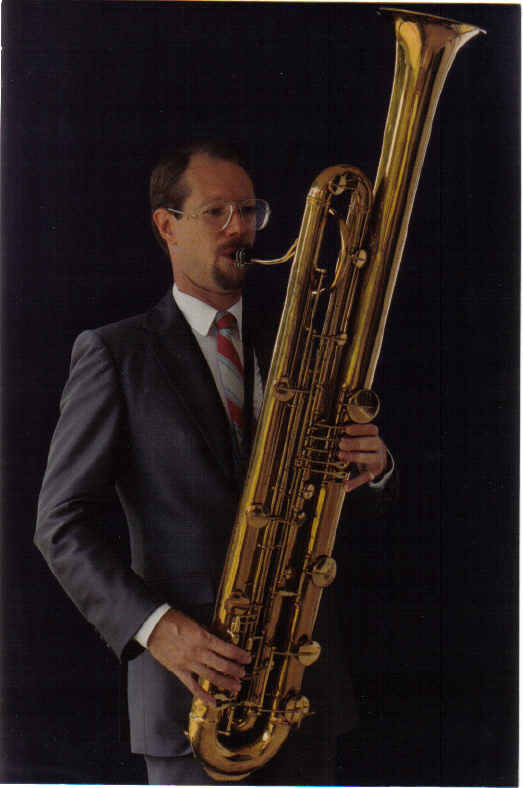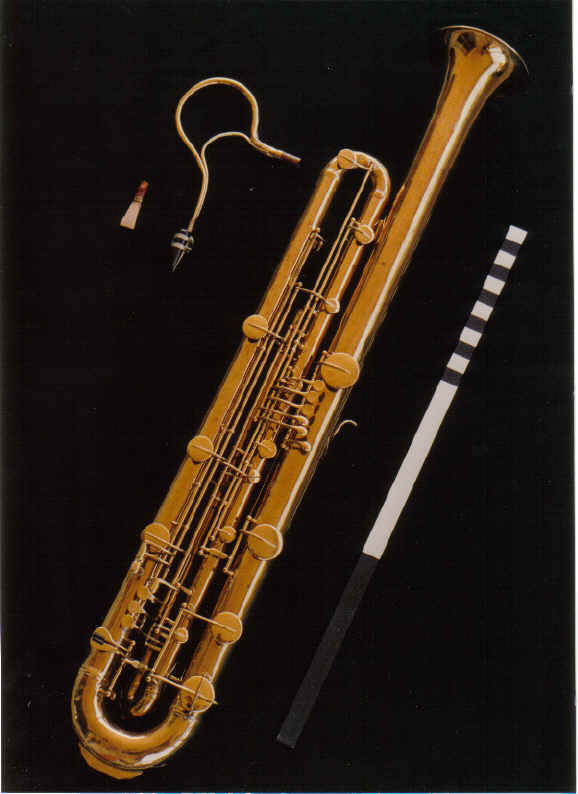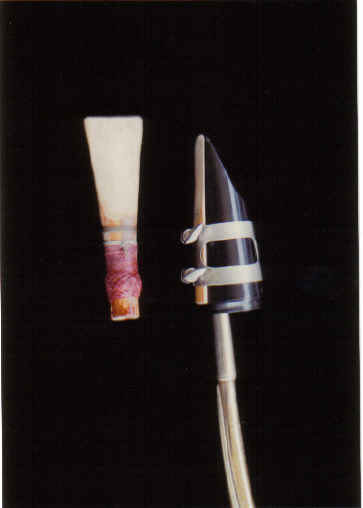The Conn New Wonder Series I
1[In 1915, Col. Conn sold his company to Carl Greenleaf and] by [1917]2, Conn was advertising that "the saxophone department has been quadrupled in size", and the 19183 catalog references the introduction of a straight soprano in E flat and a straight soprano in C. This catalog also makes mention of the Conn Microtuner and the Conn Resopad, both hailed as significant advances. These horns are referred to by Conn as "New Wonder" models, Conn saxophones of this era were seen with both soldered and drawn tone holes. The drawn tone holes are referenced by a patent engraved on the body tube [1,119,954 December 8, 1914] which was actually held by William S. Haynes, the flutemaker, and licensed to Conn. Rolled tone holes were introduced around [1917, on the alto], although straight tone holes were often found [on other pitches] for a few more years.
The 1922 catalog saw the re-introduction of the straight B flat soprano and the Conn Vacuum pad, which was designed to be installed without adhesives. The straight neck C Melody also made its debut in this year. During this period, Conn saxophones were often seen with spectacular engravings, and considerable experimentation was carried out in manufacturing techniques and design improvements. Conn was unique among American manufacturers in that a full time laboratory with a staff of six was maintained to pursue design improvements.
The Conn design laboratory employed several designers, principally Allen Loomis; Hugh Loney; Paul Hardy; Russell Kerr; Edward Gulick; and Leland Greenleaf. The legendary Santy Runyon also consulted with Conn on design matters. Loomis was known for his innovative, often bizzare, designs, many of which were never considered practical enough to enter production. Gulick might best be remembered for his design of the locking pivot screw [patents 1345486 and 1567003], a device which has frustrated repairmen for years.
During this era, Conn began trade-marking names that designated various models. These included Wonder (February 1, 1891); New Wonder (May 1, 1917); Pan American (January 29, 1918); American First (February 5, 1918); C. G. Conn [Ltd.] (April 2, 1918); and Victor New Wonder (October 15, 1918)4.
My best research indicates that Conn, Ltd. was continuing to sell the Wonder model horns until 1917, when horns were first produced with the Haynes tonehole patent, in limited quantities -- and two years after the purchase of the company by Mr. Greenleaf. I'm also assuming that these horns might have the Union label on the back of the horn (above the serial number) and have soldered tone holes. These horns, however, are engraved "C.G. Conn Ltd." instead of "C.G. Conn", a definite change from earlier models, but all horns were transitioned to the New Wonder style (including rolled tone holes) by 1920 or so.
So, one can say that the Wonder model was produced until about s/n 41xxx, even though the design is a little bit altered and may have been called the "New Wonder" model by this time3. These horns are listed on the Wonder page.
In other words, the best definition I can come up for for "true" New Wonder horns is that they must have the Haynes patent stamped on the back of them and have rolled tone holes. If these are missing, the horn is a Wonder model.
- Characteristics:
- Pearl keys appeared around 1917
- Single octave key
- Rolled tone holes (feature found on all pitches around 1919)
- Standard front F altissimo key on alto and tenor
- Horns are now engraved "C.G. Conn, Ltd.", instead of "C.G. Conn"
- "Smooth" G# key. The nail-file G# is a characteristic of the "Series II" New Wonder horns.
Other Notes: Another reason why these horns were significant is that they were the first horn stencilled in large quantities (Buffet's horns are probably the first, but nowhere near the volume of Conn). A stencil is a horn that was produced by a major saxophone manufacturer for distribution to a storefront and that store would literally take a stencil and put it over the sax's bell and engrave a pattern. There are dozens of Conn stencil models and they all lack at least one feature: rolled tone holes. All also have the Mercedes-Benz-logo-style low C keyguard and the infamous "Pat'd 1914" date near the serial number (later revised to patent dates in 1915, 1917 or 1918, for some stencils). The "Pan American" model is unofficiall
A lot of people write me e-mail to ask my comments on the value of these horns. I generally say that alto, tenor and C melody horns aren't worth much, unless they're gold (or silver and gold) or have elaborate engraving. The reason is that there were thousands of alto and tenor (both C and Bb) horns produced.
WARNING! Note that that Conn produced HIGH PITCH horns until about 1940. Modern instruments, except for some instruments used in concert orchestras in Europe, are LOW PITCH, with A (the tuning note used in orchestras) =440 hz. Some high pitch horns from other manufacturers can be used, if you've got a good ear, because they're tuned to, say, A=442. Conns are pitched around A=457. In other words, you can't play a Conn high pitch horn with other instrumentalists because you'll be seriously out of tune with them! Luckily, Conn did include the stamp "HP" or "High Pitch" above the serial number for these horns that had the odd tuning.
Models, Finishes and Engravings
- Models (odd numbers would indicate high pitch -- e.g. 11M tenor -- and are not included):5
- 20M Straight Eb Sopranino (they called it an "Eb Soprano")
- 2M C Soprano
- 4M Bb Soprano, Curved
- 18M Bb Soprano, Straight
- 6M Eb Alto
- 8M C Melody Tenor
- 10M Bb Tenor
- 12M Eb Baritone (low Bb; low A not available until 1955-ish)
- 14M Bb Bass
- Finish Choices (all from a March, 1922 catalog, unless otherwise marked):
- 000 - Virtuoso Deluxe: (introduced around 1922 for the C melody and on all models by the end of 1924 ): "Furnished only on special orders and prices quoted on request." Heavily gold plated over all, hand burnished over all. Each and every key inlaid with special choice and carefully selected pearls. Highest class hand engraving on bell of instrument, as well as a greater portion of the body, all of which is a special design and of the highest character.6
- 00 - Artist's Special ("Burnished Gold"7): Heavily gold plated, hand burnished over all, pearl inlaid keys, pearl rollers, bell richly hand-engraved. Inside of bell, engraving background, keys, posts and ferrules hand burnished.
- 0 - Artist Finish ("Satin Gold"): Heavily gold plated over all, pearl inlaid keys and rollers, bell richly hand-engraved. Inside of bell engraving background, keys, posts and ferrules hand burnished.
- 1 ("Silver & Gold"): Body heavily silver plated, sand blast velvet finish, bell richly engraved, pearl finger tips, pearl rollers. Inside of bell, engraving background keys and ferrules gold-plated and burnished.
- 2 ("Silver, Gold Bell"): Body heavily silver plated, sand blast velvet finish, bell richly engraved, inside of bell gold plated and burnished. Engraving background, keys, posts and ferrules hand burnished. Keys inlaid with pearl and pearl rollers.
- 3: Quadruple silver plated over all, sand blast finish; interior of bell and points hand burnished, finger tips pearl inlaid, and on saxophones, pearl rollers. On woodwinds this finish symbol represents heavily silver plated keys, posts and rods, hand burnished. (Not advertised in any catalog I have.)8
- 4: Highly polished brass throughout, pearl inlaid finger tips and pearl rollers.
- 5: Gold brass, highly polished, nickel-trimmed. (Not advertised in any catalog I have.)8
- 6: Body heavily nickel plated and highly polished, pearl inlaid finger tips, pearl rollers.
- Chrome Finish was the trade name for a colored enamel finish. Available colors were red, white, blue, green, Old Rose ("dark pink") and black. This was available as an add-on for any style of plating for a mere $15 extra, in March 1922 dollars.
- Poly-Chrome Finish was the trade name for the CHROME finish, but with added "beautiful designs on bell or body of flowers, vines, etc. in various colors" and cost $25 extra, in March 1922 dollars.
Conn also saw fit to enclose a NOTE: "The Chrome or Poly-Chrome finish will last according to the care given the instrument. Should the owner desire to remove the colored finish, send in the instrument to the factory or obtain our advice on same. The original finish will not be affected by the chrome finish after the latter has been removed."
There are at least seven standard engraving styles, that are slightly varied as this series progresses. There were (allegedly) around 30 engraving patterns for the Finish 00 horns -- and the engraving on the Finish 000 horns was supposed to be unique.
Please note that there are later relacquered examples with a lacquer body with silver or nickel keys. This is NOT original. In the late 1950's, Conn produced their first horns with a lacquer body and nickel keys. Conn then continued this finish choice for years. So, it seems that when some people brought in their old Conns for refinish work, the repairman would look at the horn and say: "Relacquer? Yep. All the new ones have a yellow body and nickle keys ..." not realizing the variety of plating choices Conn had. I've seen a couple of horns refurbished by Conn themselves relacquered this way!
Additionally, it is almost universally thought that lacquer was not introduced until the 6M "Naked Lady" models, starting around s/n 260xxx (1934). It seems to have been a common practice to get old bare-brass horns lacquered in the 1930's to protect the finish, but this was not original -- it may have been done by Conn themselves, but it's aftermarket.
| 20M | 2M | 4M | 18M | 6M | 8M | 10M | 12M | 14M | 16V | |
| 00 | 200 | 150 | 165 | 165 | 190 | 200 | 215 | 285 | 375 | 440 |
| 0 | 175 | 140 | 155 | 155 | 180 | 190 | 200 | 265 | 345 | 400 |
| 1 | 145 | 110 | 120 | 120 | 145 | 158 | 170 | 205 | 270 | 350 |
| 2 | 120 | 95 | 105 | 105 | 125 | 135 | 145 | 175 | 220 | 335 |
| 6 | 110 | 85 | 95 | 95 | 100 | 110 | 115 | 125 | 160 | 275 |
| 4 | 100 | 70 | 80 | 80 | 85 | 90 | 95 | 105 | 135 | 225 |
A price chart, in 1922 dollars (except for the 20M and 16V - those are in 1927 dollars). (For comparision, the 6M in finish 00 is $220 in 1927.)
ONE 1922 dollar = 10.73 2006 dollars9.
(In other words, tack another zero to the end of the price for about what that horn would have cost today.)
Finish 000 horns, I have been told, generally cost twice as much as a Finish 0 horn.
The Eb Contrabass Sarrusophone
Conn offered the Eb contrabass Sarrusophone, model 16V, as their Eb contrabass saxophone alternative, as did a few other companies, like Couesnon.
The Sarrusophone has essentially the same keywork as the saxophone, but the body is tightly curved, lighter (making them easier for marching) and has a DOUBLE reed, like a bassoon -- although Conn offered a soprano sax-like mouthpiece as an alternative.
Conn produced about 200 of these horns. There is some debate as to how long these horns were produced or available: Margaret Downie Banks puts their production years at 1921 and 1922, only, and there recently was an eBay sale listing a Conn catalog that had both the Conn-O-Sax and Sarrusophone for sale -- that'd make it a production end date of 1928 or 1929.

The earliest production start date is 1917, though. One thing isn't in dispute: Conn's primary customer for these horns was the US Army.
Interestingly enough, Conn advertised that almost all of the finishes available for the saxophone were available for the 16V. I'd love to see one of these in Old Rose enamel.
There are a bunch of articles on Sarrusophones at contrabass.com10 (with more pics and sound clips) and the International Double Reed Society11 (with specific information on the Conn instruments -- and there's also a second article13, no pun intended).
And, if you can't use your website to help someone out, what is it good for?
SAXTEK, a frequent contributor to this website, has a 16V FOR SALE (Feb. 19. 2007). Here are some details from SAXTEK:
My Sarrusophone is a Conn, one of the ones made for the army. It's a relacquer, comes with original case, original Conn single reed mouthpiece (extremely rare, and works great). I'll include a good contrabassoon reed, and a true sarrusophone double reed, old but good for reed makers to copy. I'll also include a contrabassoon fingering chart - a very old original chart, plus a photocopy.



